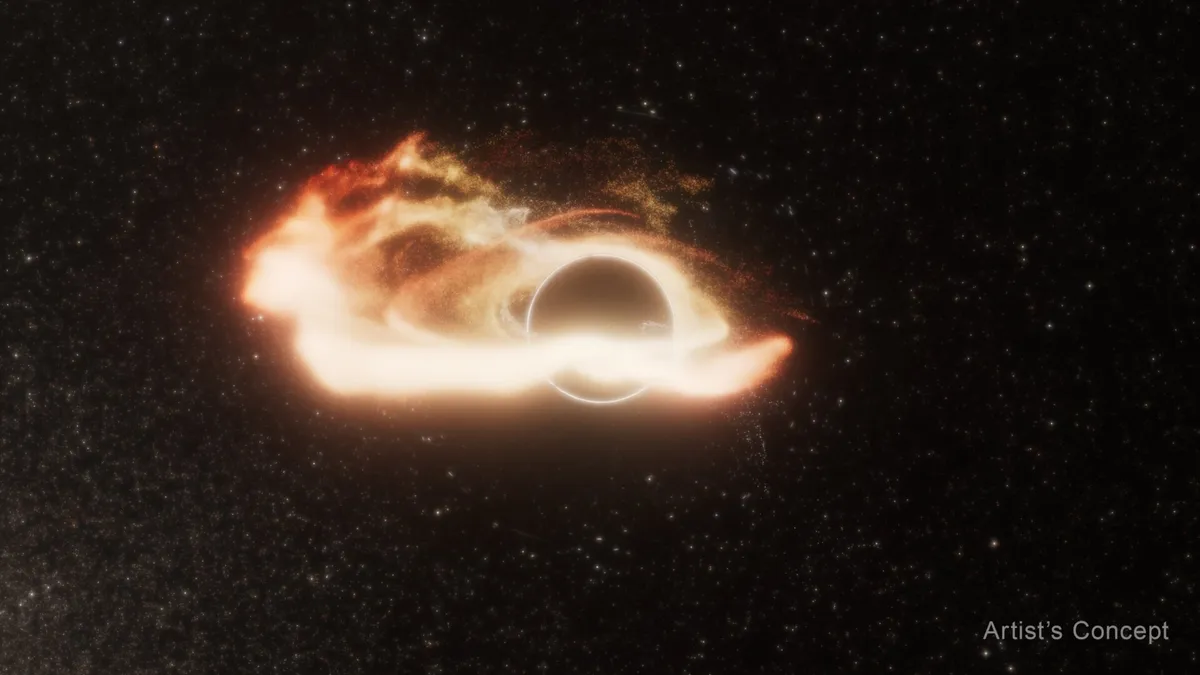
A team of astronomers has made a groundbreaking discovery, identifying an apparent supermassive black hole that is currently consuming a star located an astonishing 600 million light-years away. This cosmic event, named AT2024tvd, unfolds in a galaxy that harbors an even larger black hole at its core. The initial sighting of this phenomenon was made by the Palomar Observatory’s Zwicky Transient Facility, and it was later confirmed by renowned space telescopes such as Hubble and Chandra, which helped pinpoint the fascinating cosmic "crime scene."
In a surprising twist, researchers found that the black hole responsible for the tidal disruption event (TDE) is not positioned at the center of its host galaxy, where supermassive black holes are typically found. Instead, it is located a remarkable 2,600 light-years away from the galactic center. To put this distance into perspective, it is merely one-tenth of the distance between our Sun and Sagittarius A*, the black hole located at the center of the Milky Way galaxy.
Tidal disruption events occur when a black hole’s gravitational forces exert a violent pull on a star, stretching and shredding it in a dramatic process known as spaghettification. This event produces a massive burst of energy, rivaling the brightness of a supernova—the explosive end of a massive star. The emitted light is observable across the electromagnetic spectrum, making TDEs invaluable for detecting black holes that might otherwise remain hidden or too quiet to discover, including this recent rogue object.
AT2024tvd holds particular significance as it marks the first offset TDE identified through optical surveys, as outlined in an upcoming paper in The Astrophysical Journal Letters, which is also available on the preprint server arXiv. This discovery underscores the potential for uncovering rogue black holes—entities that warp spacetime and remain shrouded in darkness—as long as they interact with unfortunate celestial objects. According to study co-author Ryan Chornock, a researcher at the University of California – Berkeley and a member of the ZTF team, “Tidal disruption events hold great promise for illuminating the presence of massive black holes that we would otherwise not be able to detect.”
The research team has proposed several theories regarding how this rogue black hole ended up in such an unusual position within the galaxy, especially so close to the supermassive black hole at its center. The mass of the rogue black hole is estimated to be around one million solar masses, which is at least ten times smaller than the black hole situated at the galactic core. One theory suggests that the rogue black hole was once at the center of a smaller galaxy that merged with a larger one, leaving it drifting through the new, larger galaxy. Another possibility is that the black hole was part of a three-body system and was ejected by the gravitational influence of larger black holes in the core.
Yuhan Yao, the lead author of the study and a researcher at UC Berkeley, noted, “If the black hole went through a triple interaction with two other black holes in the galaxy’s core, it can still remain bound to the galaxy, orbiting around the central region.” However, the team has not yet determined whether the rogue black hole is being actively pushed away or pulled in by the larger black hole's gravity. With future astronomical instruments like the Vera Rubin Observatory and the Roman Space Telescope set to come online, researchers are optimistic that this discovery may be the beginning of a new era in black hole exploration.
The idea that black holes are roaming through space in unexpected locations adds an intriguing layer to our understanding of the universe. If the prospect of a black hole devouring a star is unsettling, the thought of these massive entities drifting silently through the cosmos is even more so. The exploration of TDEs like AT2024tvd could pave the way for uncovering the mysteries of rogue black holes and their role in the universe.